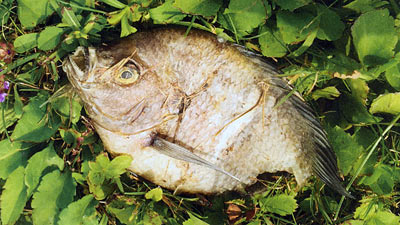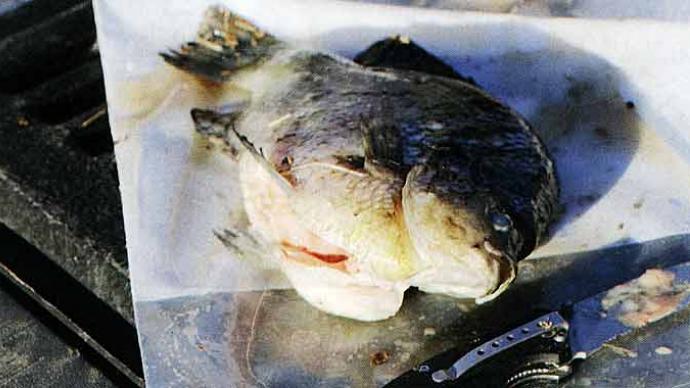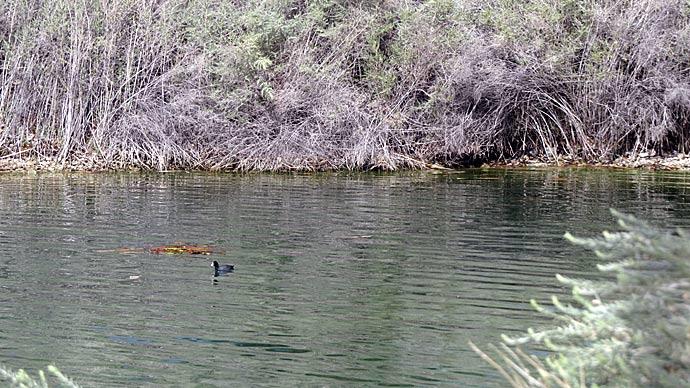
Summer is the time for BBQs, bonfires, and warm sunny days. Long daylight hours are the perfect recipe for summer fun. But while the terrestrial environment enjoys summer bliss, for a small, productive pond here in upstate New York, these conditions can contribute to a bleak state of affairs. You may have heard the term summer kill in reference to freshwater ponds and lakes, but precisely what does that mean, and how can we help our aquatic friends avoid this outcome? Let's explore this idea.
It was a warm sunny day as the phone in the fish cave rang to life, the voice on the other end heavy with concern. "My fish are not happy, many have died, and the ones still alive are concentrated near the surface and at the pond edge. What do I do?" It was a question asked many times before, and we're almost certain of the answer, but decided to investigate to be sure. "We'll be there soon!" An oxygen meter was procured from the laboratory shelf and we headed toward the nearby town where the call originated.
Upon arrival, it was clear this small (0.5-acre) pond was in deep trouble. Many dead fish lined the shore, and the water had a cloudy, brownish appearance with the tepid stagnancy and musty odor of looming disaster. The water meter probe was tossed into the pond where water was about 4 feet deep. Most fish begin to stress when the oxygen content drops below 4 mg/1. Most are in dire need of a breath at 3 mg/1, and much below that benchmark number most will perish. The display on our meter read 1.8 mg/1. Suspicions were confirmed. The oxygen in the pond had plummeted, initiating the summer kill But what caused this? The question seems simple, but the answer can be rather complex and often involves a series of compounding factors that contribute to the scenario we had just witnessed.
WARNING: SCIENCE CONTENT AHEAD: There are two major pathways for oxygen to enter a pond—by wind-assisted diffusion from contacting the atmosphere, and photosynthetic activity from aquatic plants and algae during daylight hours. It should be noted this second pathway is a bit deceiving, because at night these photosynthetic organisms respire, and consume oxygen instead of producing it. On warm, windless, cloudy days in the summer the diffusion pathway is greatly reduced. Warm water holds less oxygen than cold water, and the undisturbed water provides the smallest possible surface area for diffusion. On top of this, the warm spring air and lack of wind can lead to thermal stratification, the condition where the pond has layers of different temperature water that tends not to mix. With heat wanting to rise, a layer-cake effect occurs. A thermocline is formed, separating the warm layer from the cooler layer beneath. This means that any oxygen that does manage to make it into solution cannot penetrate to the cooler bottom waters. The pond in this state will lose oxygen from the bottom-up to the thermocline until prevailing conditions change.
In addition to the physical process described above, chemical decomposition of organic material—like dead plants and algae—consume oxygen, making the problem worse. As it turns out, nutrients are the driving force of this natural process. More nutrients —? more plant and algae production —? more decomposition, causing the bottom waters (and in severe cases, the surface) to become anoxic. So, regardless of the nuances of individual circumstance, most summer kill events boil down to two primary causes: (1) Low oxygen from reduced diffusion and mixing, and (2) Low oxygen resulting from increased consumption/decomposition due to excess nutrients/productivity. Either one of these circumstances can also be triggered by a rapid temperature drop, often caused by a summer rainstorm. When the upper layer of water quickly cools to similar temperatures as that deeper layer, the two layers instantly mix. People call this a pond turnover. Anoxic bottom water mixes with the oxygen-rich upper layer, absorbing oxygen until the entire system plummets. When that happens, fish die.
Algae-dominated systems tend to have a higher risk of experiencing a summer kill due to algae's short life cycle. Dying plants provide a constant stream of organic material falling to the bottom to absorb oxygen while being decomposed, whereas most rooted plants senesce (die) and enter dormancy in late fall when cooler waters and better mixing prevail. In the pond described earlier, the brown water was due to an algal bloom that crashed, consuming vast amounts of oxygen. This algal bloom was caused by grass carp overgrazing rooted plants. The pond was devoid of rooted aquatic vegetation, with not a stem to be found.
In aquatic systems, when nutrients are present, something will use them. Nature won't allow it any other way. In this case, algae seized the opportunity as grass carp munched leafy plants and gave them back to the pond as waste. The nutrients in the pond were feeding a bloom that collapsed as brown, nasty, decaying algae rather than rooted plants or green phytoplankton (algae).
One other noteworthy item, this pond had a food web that was completely out of balance. There were three species of dead fish found floating in the pond. We saw plenty of fish that were still alive, if they can overcome this event. There were grass carp, fathead minnows, and small bluegill by the THOUSANDS. The grass carp were eating all the plants (including the edge of the lawn!), while small minnows and bluegill were eating large crustacean zooplankton grazers, like water fleas. This kept the algal bloom going. The algae fell to the bottom and decomposed, using the oxygen from the bottom. This pond was in need of a predator, like Largemouth, or better yet, smallmouth bass. Stocking 10-12" bass at a density of 30-50/acre in this pond would knock down the bluegill, allowing some large bodied zooplankton to return and graze some of that algae out of the water. Predators would indirectly help water quality.
When considering the effect of the food web on water clarity, and ultimately oxygen levels in the depth, nutrients should be locked up in big predators, big plankton, and low algal biomass. Flip-flopping the food web in this pond was a must to make the water clearer. We needed to increase predation on those dominant little fish.
So, what did we suggest to help this pond? There was a single solution with the potential to solve both problems—to increase the oxygen level in the pond. In this pond, the owner needed to aerate first, turning over the bottom waters all year, except under the ice. This could be accomplished by directly adding oxygen with a compressor and air stone, or by circulation to mix the pond and increase diffusion. Consistent aeration will promote healthy algae, rather than the species of algae that are problematic in this system. Some algae are more palatable to crustacean grazers.
In addition, reducing nutrients in the pond will help reduce oxygen consumption. This pond owner is currently blowing the grass clippings into the pond as she mows the lawn. This should stop. Bag those clippings and compost elsewhere. Also, the landowner needs to harvest his grass carp immediately. He has too many for this size pond. The grass carp started out small and grew very large. This is a common grass carp problem in upstate New York. Now these carp are huge, they have run out of food, and are causing physical and biological clarity issues. Remove them. Next, we recommended they try not to inadvertently fertilize near the pond—this includes fertilizing their yard upslope from the pond, as some of these nutrients will find their way to the water. And finally, stock some bass to eat those small planktivorous fish, locking nutrients up in something other than brown algae and small baitfish.
Ben German is a Senior Fisheries Technician in the Dept. of Fish, Wildlife & Environmental Science at SUNY Cobleskill.
Reprinted with permission from Pond Boss Magazine



